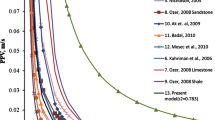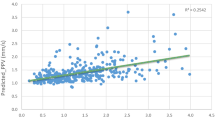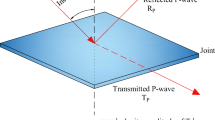Abstract
Blast-induced ground vibrations are considered as an undesirable phenomenon resulting from productivity explosions in the extractive industries. Moreover, they are considered as a high potential cause for the damage of the surrounding structures. In this paper, the ground vibration data were recorded using a seismograph device at different distances from the detonation point in the quarry site of “Sococim Cement Factory,” which is located on Senegal. Thereafter, 2D axisymmetric numerical model has been established to simulate the propagation of the mechanical shock wave in the considered medium. The numerical modeling was developed under AUTODYN software, which is an explicit FEM code. First of all, the numerical model has been validated against the experimental measurements, by comparing the numerical and experimental longitudinal (\(V_{{\rm l}}\)) and vertical (\(V_{\mathrm{v}}\)) velocity signal at different gauges, for different equivalent explosive charges per delay (\(m_{\mathrm{eq(TNT)}}\)). A calibration was carried out only on the elastic properties of the rock to achieve this purpose. The adjusted values of K and G allowed to reproduce the numerical PPVs, in order to be in a good agreement with the measured PPVs. The energy dissipation due to the RHT model and the phenomenon of vibration’s damping as a function of time at the gauges locations is well reproduced by the numerical model. It is noted that the plasticity and damage near the borehole have no effect on the propagation celerity of the shock wave, which remains the same in the elastic medium. Furthermore, the damaged zone nearby the detonation point has been assessed and described by identifying the transition of limestone properties from the elastic–plastic to plastic-damage state. The characterization of the damaged zone, near the borehole for different explosive charges per delay, helps to calculate the face burden side and to enhance the blasting design.
Graphic Abstract




















Similar content being viewed by others
Abbreviations
- C :
-
Porous sound speed (m/s)
- \(C_{\mathrm{L}}\), \(C_{\mathrm{T}}\) :
-
Longitudinal and transversal celerities (m/s)
- \(C_{\mathrm{s}}\) :
-
Bulk sound speed (m/s)
- e :
-
Internal energy (J)
- \(ef_{\mathrm{min}}\) :
-
Minimum strain to failure
- E :
-
Young modulus (kPa)
- \(\mathbf {f}\) :
-
Vector of external force (N)
- \(f_{\mathrm{c,el}}\) :
-
Elastic compressive strength (MPa)
- \(f_{\mathrm{t,el}}\) :
-
Elastic tensile strength (MPa)
- \(f_{\mathrm{c}}\) :
-
Uniaxial compressive strength (MPa)
- \(f_{\mathrm{s}}\) :
-
Shear strength (MPa)
- \(f_{\mathrm{t}}\) :
-
Uniaxial tensile strength (MPa)
- G :
-
Elastic shear modulus (kPa)
- I :
-
Identity tensor
- K :
-
Elastic bulk modulus (kPa)
- L :
-
Length (m)
- \(L_{\mathrm{TNT}}\) :
-
Length of TNT (m)
- \(m_{\mathrm{eq(TNT)}}\) :
-
Equivalent mass of TNT (kg)
- N :
-
Compaction exponent
- p :
-
Pressure (Pa)
- \(p_{\mathrm{comp}}\) :
-
Solid compaction pressure (Pa)
- \(p_{\mathrm{el}}\) :
-
Initial compaction pressure (Pa)
- t :
-
Time (s)
- \(U_{x}\), \(U_{y}\) :
-
Mechanical displacements (m)
- \(\mathbf {v}\) :
-
Velocity vector (m/s)
- \(V_{{\rm l}}\), \(V_{\mathrm{v}}\) :
-
Longitudinal and vertical velocities (m/s)
- \(Y_{\mathrm{elastic}}\) :
-
Yield surface
- \(Y_{\mathrm{fail}}\) :
-
Failure surface
- \(Y_{\mathrm{fric}}\) :
-
Residual friction resistance surface
- \(\gamma\) :
-
Ratio of specific heats
- \(\mu\) :
-
Dynamic viscosity (Pa.s)
- \(\nu\) :
-
Poisson coefficient
- \(\rho\) :
-
Density (kg/cm\(^{3}\))
- \(\rho _{0}\) :
-
Initial density (kg/cm\(^{3}\))
- \(\rho _{\mathrm{TMD}}\) :
-
Theoretical maximal density (kg/cm\(^{3}\))
- \(\sigma\) :
-
Total Cauchy stress tensor (kPa)
- \(\alpha\) :
-
Porosity parameter
- \(\alpha _{\mathrm{int}}\) :
-
Initial porosity
- \(\theta\) :
-
Lode angle
- \(\varGamma\) :
-
Grüneisen parameter
- \(\frac{\rho _{\mathrm{matrix}}}{\rho _{\mathrm{porous}}}\) :
-
Additional state variable
- \(\epsilon\) :
-
Strain rate
- BIGVs:
-
Blast-induced ground vibrations
- PPV:
-
Peak particle velocity
- FEM:
-
Finite element method
- RHT:
-
Riedel, Hiermaier and Thoma
References
Afeni TB, Osasan SK (2009) Assessment of noise and ground vibration induced during blasting operations in an open pit mine—a case study on Ewekoro limestone quarry, Nigeria. Min Sci Technol (China) 19(4):420–424
AUTODYN: Theory manual. Century Dynamics (2006)
Coulombez C (2007) Analyse et optimisation des pratiques d’abattage a l’explosif dans une carrière de granulats
David ES, Stachura VJ, Stagg MS, Kopp JW (1980) Structure response and damage produced by ground vibration from surface mine blasting. Report of Investigations 8485, pp 1–112
Esmaeili M, Tavakoli B (2019) Finite element method simulation of explosive compaction in saturated loose sandy soils. Soil Dyn Earthq Eng 116:446–459. https://doi.org/10.1016/j.soildyn.2018.09.048
Hanchak S, Forrestal M, Young E, Ehrgott J (1992) Perforation of concrete slabs with 48 MPa (7 ksi) and 140 MPa (20 ksi) unconfined compressive strengths. Int J Impact Eng 12(1):1–7
Herrmann W (1969) Constitutive equation for the dynamic compaction of ductile porous materials. J Appl Phys 40(6):2490–2499
Holmquist TJ, Johnson GR (2011) A computational constitutive model for glass subjected to large strains, high strain rates and high pressures. J Appl Mech 78(5):051003
Hu Y, Chen L, Fang Q, Xiang H (2018) Blast loading model of the RC column under close-in explosion induced by the double end initiation explosive cylinder. Eng Struct 175:304–321. https://doi.org/10.1016/j.engstruct.2018.08.013
Iphar M, Yavuz M, Ak H (2008) Prediction of ground vibrations resulting from the blasting operations in an open-pit mine by adaptive neuro-fuzzy inference system. Environ Geol 56(1):97–107
Jehel P (2014) A critical look into Rayleigh damping forces for seismic performance assessment of inelastic structures. Eng Struct 78:28–40. https://doi.org/10.1016/j.engstruct.2014.08.003 (Performance Based Engineering: Current Advances and Applications)
Khandelwal M, Singh T (2006) Prediction of blast induced ground vibrations and frequency in opencast mine: a neural network approach. J Sound Vib 289(4):711–725. https://doi.org/10.1016/j.jsv.2005.02.044
Laine L, Sandvik A (2001) Derivation of mechanical properties for sand. In: Proceedings of the 4th Asia-Pacific conference on shock and impact loads on structures, CI-Premier PTE LTD, Singapore, vol 361. ANSYS Inc, p 368
Lee E, Finger M, Collins W (1973) JWL equation of state coefficients for high explosives. Technical report, Lawrence Livermore National Lab. (LLNL), Livermore, CA, USA
Li M, Zhu Z, Liu R, Liu B, Zhou L, Dong Y (2018) Study of the effect of empty holes on propagating cracks under blasting loads. Int J Rock Mech Min Sci 103:186–194. https://doi.org/10.1016/j.ijrmms.2018.01.043
Linforth S, Tran P, Rupasinghe M, Nguyen N, Ngo T, Saleh M, Odish R, Shanmugam D (2018) Unsaturated soil blast: flying plate experiment and numerical investigations. Int J Impact Eng. https://doi.org/10.1016/j.ijimpeng.2018.08.002
Lu W, Yang J, Chen M, Zhou C (2011) An equivalent method for blasting vibration simulation. Simul Model Pract Theory 19(9):2050–2062. https://doi.org/10.1016/j.simpat.2011.05.012
Maragakis E, Saiidi M, Abdel-Ghaffar S (1993) Response of r/c buildings during the 1987 whittier narrows earthquake. Earthq Spectra 9(1):67–95
Mohotti D, Ngo T, Raman SN, Mendis P (2015) Analytical and numerical investigation of polyurea layered aluminium plates subjected to high velocity projectile impact. Mater Des 82:1–17. https://doi.org/10.1016/j.matdes.2015.05.036
Murmu S, Maheshwari P, Verma HK (2018) Empirical and probabilistic analysis of blast-induced ground vibrations. Int J Rock Mech Min Sci 103:267–274. https://doi.org/10.1016/j.ijrmms.2018.01.038
Nateghi R (2012) Evaluation of blast induced ground vibration for minimizing negative effects on surrounding structures. Soil Dyn Earthq Eng 43:133–138. https://doi.org/10.1016/j.soildyn.2012.07.009
Ongen T, Karakus D, Konak G, Onur AH (2018) Assessment of blast-induced vibration using various estimation models. J Afr Earth Sci 145:267–273. https://doi.org/10.1016/j.jafrearsci.2018.05.004
Rao B, Chen L, Fang Q, Hong J, Xian LZ, Bo XH (2018) Dynamic responses of reinforced concrete beams under double-end-initiated close-in explosion. Def Technol 14(5):527–539. https://doi.org/10.1016/j.dt.2018.07.024
Riedel W (2000) Beton unter dynamischen lasten–meso-und makromechanische modelle und ihre parameter. forschungsergebnisse aus der kurzzeitdynamik. Fraunhofer Institut für Kurzzeitdynamik, Ernst-Mach-Institut, Freiburg
Riedel W, Kawai N, Kondo Ki (2009) Numerical assessment for impact strength measurements in concrete materials. Int J Impact Eng 36(2):283–293
Riedel W, Thoma K, Hiermaier S, Schmolinske E (1999) Penetration of reinforced concrete by beta-b-500 numerical analysis using a new macroscopic concrete model for hydrocodes. In: Proceedings of the 9th international symposium on the effects of munitions with structures, vol 315. Berlin-Strausberg, Germany
Saleh M, Edwards L (2015) Evaluation of soil and fluid structure interaction in blast modelling of the flying plate test. Comput Struct 151:96–114. https://doi.org/10.1016/j.compstruc.2015.01.010
Salvado FC, Tavares AJ, Teixeira-Dias F, Cardoso JB (2017) Confined explosions: the effect of compartment geometry. J Loss Prev Process Ind 48:126–144. https://doi.org/10.1016/j.jlp.2017.04.013
Sauer C, Heine A, Riedel W (2017) Developing a validated hydrocode model for adobe under impact loading. Int J Impact Eng 104:164–176. https://doi.org/10.1016/j.ijimpeng.2017.01.019
Shi Y, Stewart MG (2015) Spatial reliability analysis of explosive blast load damage to reinforced concrete columns. Struct Saf 53:13–25. https://doi.org/10.1016/j.strusafe.2014.07.003
Singiresu SR et al (1995) Mechanical vibrations, Addison Wesley
Tang EK, Hao H (2010) Numerical simulation of a cable-stayed bridge response to blast loads, part I: model development and response calculations. Eng Struct 32(10):3180–3192. https://doi.org/10.1016/j.engstruct.2010.06.007
Verma H, Samadhiya N, Singh M, Goel R, Singh P (2018) Blast induced rock mass damage around tunnels. Tunn Undergr Space Technol 71:149–158. https://doi.org/10.1016/j.tust.2017.08.019
Yi C, Sjöberg J, Johansson D (2017) Numerical modelling for blast-induced fragmentation in sublevel caving mines. Tunn Undergr Space Technol 68:167–173. https://doi.org/10.1016/j.tust.2017.05.030
Zeng Y, Li H, Xia X, Liu B, Zuo H, Jiang J (2018) Blast-induced rock damage control in Fangchenggang Nuclear Power Station, China. J Rock Mech Geotech Eng 10(5):914–923. https://doi.org/10.1016/j.jrmge.2018.04.010
Zhang QL, Li DY, Wang F, Li B (2018) Numerical simulation of nonlinear structural responses of an arch dam to an underwater explosion. Eng Fail Anal 91:72–91. https://doi.org/10.1016/j.engfailanal.2018.04.025
Zhao JJ, Zhang Y, Ranjith P (2017) Numerical simulation of blasting-induced fracture expansion in coal masses. Int J Rock Mech Min Sci 100:28–39. https://doi.org/10.1016/j.ijrmms.2017.10.015
Zhao X, Wang G, Lu W, Chen M, Yan P, Zhou C (2018) Effects of close proximity underwater explosion on the nonlinear dynamic response of concrete gravity dams with orifices. Eng Fail Anal 92:566–586. https://doi.org/10.1016/j.engfailanal.2018.06.016
Zhi X, Qi S, Fan F, Zhai X (2018) Experimental and numerical investigations of a single-layer reticulated dome subjected to external blast loading. Eng Struct 176:103–114. https://doi.org/10.1016/j.engstruct.2018.08.105
Zhu JB, Li YS, Wu SY, Zhang R, Ren L (2018) Decoupled explosion in an underground opening and dynamic responses of surrounding rock masses and structures and induced ground motions: a fem–dem numerical study. Tunn Undergr Space Technol 82:442–454. https://doi.org/10.1016/j.tust.2018.08.057
Acknowledgements
The authors wish to express their gratitude to “Sococim company” for good hospitality and cooperation.
Author information
Authors and Affiliations
Corresponding author
Ethics declarations
Conflict of interest
The authors declare that they have no conflict of interest.
Additional information
Publisher's Note
Springer Nature remains neutral with regard to jurisdictional claims in published maps and institutional affiliations.
Rights and permissions
About this article
Cite this article
Kadiri, I., Tahir, Y., Fertahi, S.eD. et al. Measurement and 2D Axisymmetric Modeling of Mining Blast-Induced Ground Vibrations. Indian Geotech J 50, 96–116 (2020). https://doi.org/10.1007/s40098-019-00388-0
Received:
Accepted:
Published:
Issue Date:
DOI: https://doi.org/10.1007/s40098-019-00388-0




